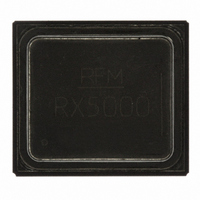RX5000 RFM, RX5000 Datasheet - Page 5

RX5000
Manufacturer Part Number
RX5000
Description
ASH RX 115.2 KBPS 433.92 MHZ
Manufacturer
RFM
Type
Receiverr
Datasheet
1.RX5000.pdf
(10 pages)
Specifications of RX5000
Frequency
433.92MHz
Sensitivity
-109dBm
Data Rate - Maximum
115.2kbps
Modulation Or Protocol
ASK, OOK
Applications
General Data Transfer
Current - Receiving
3.8mA
Data Interface
PCB, Surface Mount
Antenna Connector
PCB, Surface Mount
Voltage - Supply
2.2 V ~ 3.7 V
Operating Temperature
-40°C ~ 85°C
Package / Case
SM-20L
Operating Frequency
434.12 MHz
Operating Supply Voltage
2.5 V or 3.3 V
Maximum Operating Temperature
+ 85 C
Minimum Operating Temperature
- 40 C
Mounting Style
SMD/SMT
Supply Current
3 mA
Lead Free Status / RoHS Status
Lead free by exemption / RoHS compliant by exemption
Features
-
Memory Size
-
Lead Free Status / Rohs Status
Lead free / RoHS Compliant
Other names
583-1074-2
Available stocks
Company
Part Number
Manufacturer
Quantity
Price
www.RFM.com
©2008 by RF Monolithics, Inc.
receiver, the overall cycle time between the start of one RFA1 ON
sequence and the start of the next RFA1 ON sequence should be
set to sample the narrowest RF data pulse at least 10 times.
Otherwise, significant edge jitter will be added to the detected data
pulse.
RX5000 Series ASH Receiver Block Diagram
Figure 2 is the general block diagram of the RX5000 series ASH
receiver. Please refer to Figure 2 for the following discussions.
Antenna Port
The only external RF components needed for the receiver are the
antenna and its matching components. Antennas presenting an
impedance in the range of 35 to 72 ohms resistive can be
satisfactorily matched to the RFIO pin with a series matching coil
and a shunt matching/ESD protection coil. Other antenna
impedances can be matched using two or three components. For
some impedances, two inductors and a capacitor will be required.
A DC path from RFIO to ground is required for ESD protection.
Receiver Chain
The output of the SAW filter drives amplifier RFA1. This amplifier
includes provisions for detecting the onset of saturation (AGC Set),
and for switching between 35 dB of gain and 5 dB of gain (Gain
Select). AGC Set is an input to the AGC Control function, and Gain
Select is the AGC Control function output. ON/OFF control to
RFA1 (and RFA2) is generated by the Pulse Generator & RF Amp
Bias function. The output of RFA1 drives the SAW delay line, which
has a nominal delay of 0.5 µs.
The second amplifier, RFA2, provides 51 dB of gain below
saturation. The output of RFA2 drives a full-wave detector with 19
dB of threshold gain. The onset of saturation in each section of
ESD
Choke
Antenna
RFIO
20
E-mail: info@rfm.com
CR Filter
SAW
RFA1
PRATE
CNTRL1
Pulse Generator
& RF Amp Bias
17
Bias Control
14
Gain Select
R
RX5000 Series ASH Receiver Block Diagram
Delay Line
AGC Set
PR
SAW
CNTRL0
15
18
PWIDTH
R
PW
RFA2
Power
Down
Control
AGCCAP
Log
Detector
Control
AGC
VCC1: Pin 2
VCC2: Pin 16
GND1: Pin 1
GND2: Pin 10
GND3: Pin 19
NC:
RREF: Pin 11
CMPIN: Pin 6
3
C
Figure 2
AGC
LPFADJ
Pin 8
Low-Pass
Filter
RFA2 is detected and summed to provide a logarithmic response.
This is added to the output of the full-wave detector to produce an
overall detector response that is square law for low signal levels,
and transitions into a log response for high signal levels. This
combination provides excellent threshold sensitivity and more than
70 dB of detector dynamic range. In combination with the 30 dB of
AGC range in RFA1, more than 100 dB of receiver dynamic range
is achieved.
The detector output drives a gyrator filter. The filter provides a
three-pole, 0.05 degree equiripple low-pass response with
excellent group delay flatness and minimal pulse ringing. The 3 dB
bandwidth of the filter can be set from 4.5 kHz to 1.8 MHz with an
external resistor.
The filter is followed by a base-band amplifier which boosts the
detected signal to the BBOUT pin. When the receiver RF amplifiers
are operating at a 50%-50% duty cycle, the BBOUT signal
changes about 10 mV/dB, with a peak-to-peak signal level of up to
685 mV. For lower duty cycles, the mV/dB slope and peak-to-peak
signal level are proportionately less. The detected signal is riding
on a 1.1 Vdc level that varies somewhat with supply voltage,
temperature, etc. BBOUT is coupled to the CMPIN pin or to an
external data recovery process (DSP, etc.) by a series capacitor.
The correct value of the series capacitor depends on data rate,
data run length, and other factors as discussed in the ASH
Transceiver Designer’s Guide.
When an external data recovery process is used with AGC,
BBOUT must be coupled to the external data recovery process
and CMPIN by separate series coupling capacitors. The AGC
reset function is driven by the signal applied to CMPIN.
9
R
AGC Reset
LPF
BB
5
C
BBO
6
BBOUT
PKDET
Detector
Peak
AGC
4
THLD1
C
PKD
Ref
13
Ref
R
Threshold
TH1
Control
DS2
DS1
11
dB Below
Peak Thld
R
Thld
REF
R
TH2
12
THLD2
AND
7
RX5000 - 4/7/08
RXDATA
Page 5 of 10


















